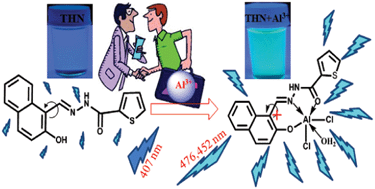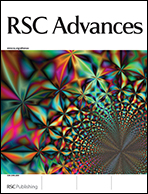An efficient fluorescent receptor (E)-N-[(2-hydroxy-naphthalen-1-yl)methylene]thiophene-2-carbohydrazide (THN) for Al3+ ions was synthesized and characterized by physicochemical and spectroscopic tools along with single crystal X-ray crystallography. This is the first report showing the crystal structure of THN and its sensing property for Al3+ ions. THN selectively and sensitively detects Al3+ ions without any interference among various cations, Na+, K+, Ca2+, Cr3+, Mg2+, Mn2+, Fe3+, Co2+, Ni2+, Cu2+, Zn2+ and Hg2+ by a strong fluorescent change in ethanol–water medium (EtOH–H2O, 1 : 4 v/v). The THN interacts with Al3+ in a tridentate mode to form a [AlCl2(THN)(H2O)]·H2O complex. The binding constant was determined to be 7.06 × 106 M−1 and the limit of detection (LOD) was calculated to be 1.35 × 10−9 M which is the second highest reported till date in the literature. The 1H NMR titration, ESI-MS and DFT studies have also been performed in support of the binding details of the THN–Al3+ complex.

You have access to this article
 Please wait while we load your content...
Something went wrong. Try again?
Please wait while we load your content...
Something went wrong. Try again?


 Please wait while we load your content...
Please wait while we load your content...